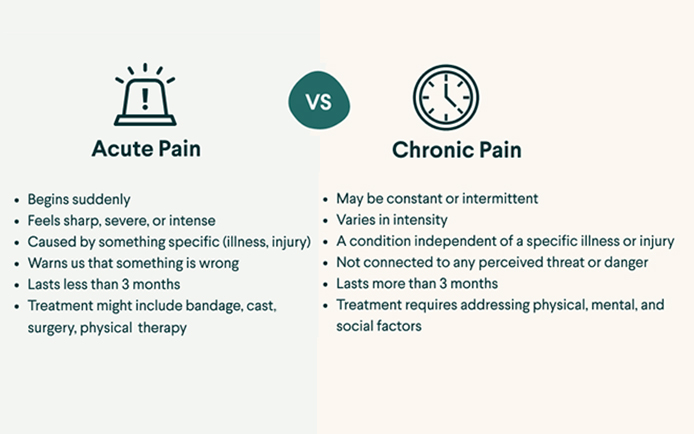Pain is a unique experience that differs for just about everyone. With the right treatment, some pain fades as soon as an injury heals or an illness is cured. But for others, the pain lingers – for months or even years. We use acute and chronic to describe these different types of pain, but how are these terms defined and why does pain last longer for some?
Acute Pain
Acute pain comes on quickly, generally as a result of a specific injury or illness. The pain is typically a sharp sensation, but it can often subside within days or weeks as the injury is treated and the tissues have a chance to heal.
For example, if you sprain your ankle, you might immediately feel pain around that area. It may become swollen over the following days, and it may be difficult to walk around as you normally would. You might use ice and elevate your ankle to help reduce swelling and decrease pain. When you see a doctor, they may recommend using a brace for a short period of time, and then prescribe exercises to help you heal. As you heal, your doctor or physical therapist will continue to monitor pain levels to make sure you heal correctly and that your pain levels decrease over time.
However, if the pain doesn’t decrease over time, if it becomes persistent, it may develop into chronic pain.
Chronic Pain
By contrast, chronic pain lasts longer than 3 months. When pain is chronic, it is often no longer tied to one specific physical injury or ailment, but involves emotional and social factors, as well. In fact, chronic pain can be considered a condition in and of itself.
This is because pain is processed by the nervous system – it receives and sends signals around the body, and pain can often serve as a warning about potential damage. However, when the body feels pain and there is no real or perceived threat, this system has malfunctioned. Chronic pain is the result.
The Impact of Chronic Pain
The estimates of adults living in the U.S. who report chronic pain vary widely, but in 2016, the CDC reported that roughly 50 million adults in the United State were dealing with chronic pain1. That’s about 20% of the U.S. population. Financially, chronic pain costs between $560 – 635 billion annually through direct healthcare costs as well as loss of work productivity.
On a personal level, when pain becomes chronic, people begin to adapt their lifestyles to avoid anything that might cause them to feel pain. Oftentimes fear of pain decreases overall physical activity. That can be protective in the beginning of the healing process, but over time, it can become overprotective – that can lead to more fear and avoidance of pain and movements. This fear of movement can also result in a person isolating themselves from their regular daily activities and from interacting with friends and family.
Sleep is negatively impacted for those with chronic pain. In fact, 65% of people with chronic pain suffer from a sleep disorder. And the constant worry and fear of experiencing pain in the future means roughly 50% of people who live with chronic pain have an anxiety disorder. Chronic pain has also been linked to changes in nutrition that can contribute to poorer health outcomes.
The challenge of addressing all these issues is ultimately the way we, as a society, understand pain. We believe that if we experience pain, then something in our body must be broken. So we seek out more medical care – more surgeries, more prescriptions, more ways trying to fix the physical issue.
But the truth is that the amount of pain a person experiences does not necessarily equal the amount of damage done to the body. Those who experience pain chronically need additional support that extends beyond addressing a physical injury or illness. They need a new way of thinking about pain.
Sources:
- Dahlhamer J, Lucas J, Zelaya, C, et al. Prevalence of Chronic Pain and High-Impact Chronic Pain Among Adults — United States, 2016. MMWR Morb Mortal Wkly Rep 2018;67:1001–1006. DOI: http://dx.doi.org/10.15585/mmwr.mm6736a2
- Definitions of Chronic Pain Syndromes. International Association for the Study of Pain. Retrieved 21 February 2022, from https://www.iasp-pain.org/advocacy/definitions-of-chronic-pain-syndromes/.
- Gaskin DJ, Richard P. The Economic Costs of Pain in the United States. In: Institute of Medicine (US) Committee on Advancing Pain Research, Care, and Education. Relieving Pain in America: A Blueprint for Transforming Prevention, Care, Education, and Research. Washington (DC): National Academies Press (US); 2011. Appendix C. Available from: https://www.ncbi.nlm.nih.gov/books/NBK92521/
- Injury. American Society of Anesthesiologists. Retrieved 21 February 2022, from https://www.asahq.org/madeforthismoment/pain-management/types-of-pain/injury/.
- Lin Y, De Araujo I, Stanley G, Small D, Geha P (2022) Chronic pain precedes disrupted eating behavior in low-back pain patients. PLoS ONE 17(2): e0263527. https://doi.org/10.1371/journal.pone.0263527
- Martin, Robroy & Davenport, Todd & Fraser, John & Sawdon-Bea, Jenna & Carcia, Christopher & Carroll, Lindsay & Kivlan, Benjamin & Carreira, Dominic. (2021). Ankle Stability and Movement Coordination Impairments: Lateral Ankle Ligament Sprains Revision 2021: Clinical Practice Guidelines Linked to the International Classification of Functioning, Disability and Health From the Academy of Orthopaedic Physical Therapy of the American Physical Therapy Association. Journal of Orth
- Melkevik O, Clausen T, Pedersen J, Garde AH, Holtermann A, Rugulies R. Comorbid symptoms of depression and musculoskeletal pain and risk of long term sickness absence. BMC Public Health. 2018;18(1):981. Published 2018 Aug 6. doi:10.1186/s12889-018-5740-yopaedic & Sports Physical Therapy. 51. CPG1-CPG80. 10.2519/jospt.2021.0302






